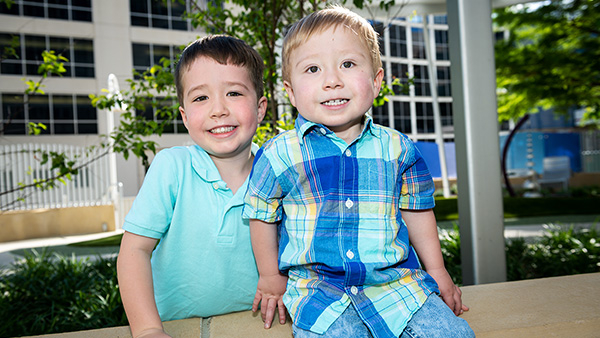
Double Your Donation With A Matching Gift
Employer matching gift programs are an easy way to make your donation go further. Donors can double (or even triple) their contributions to Children’s Medical Center Foundation by simply asking your employer if they have an existing donation matching program.
How Does Donation Matching Work?
Don't see your employer listed when searching for your company? Reach out to your company's personnel department to explore what options may be available.
What is Donation Matching?
Donation matching is a fundraising strategy where companies financially match donations that their employees make to nonprofit organizations. This can give the employee an additional reason to donate to charity, while also allowing their donation to have a larger impact. We recommend asking your human resources representative for more information about your employer’s matching gift program, and/or you can see if your employer will match your donation on our donation form.
How do matching donations work?

Step 1 – You donate
Your generous donation to Children’s Health directly supports life-changing care for children.

Step 2 – Employer match is requested
You submit a matching gift request through your employer’s program, amplifying your impact at no additional cost to you.

Step 3 – Donation is doubled
Your employer’s matching contribution doubles your donation, providing twice the support for the children and families served by Children’s Health.
There are different ratios for donation matching. Some companies do a direct 1:1 ratio, but others have different standards. Sometimes minimum donation requirements must be met before a gift is matched, which is why it is important to contact your human resources representative and to do your research prior to making a donation.
What Are the Benefits of Matching Donations?
Matching donations through your employer is a great way to maximize the impact of your gift to Children’s Medical Center Foundation.
This means that your donation will fund twice the number of patients, programs and services by supporting areas like clinical research, behavioral and mental health and the growing pediatric population of North Texas.
Children’s Health specific programs that have benefited from matching donations:
How to Get Your Employer to Match a Donation
By participating in your employer’s matching gift program, you can double or even triple the impact of your charitable match to Children’s Health. Corporate matching gift programs are a powerful way to support life-changing care for children while leveraging your employer’s generosity.
1. Check if your employer offers a gift matching program
Many companies offer corporate matching gift programs to amplify their employees’ charitable contributions. Contact your HR department or check your company’s intranet to confirm if a matching gift program is available.
2. Review your employer’s matching gift process
Each company has specific guidelines for gift matching, including eligible organizations, match ratios and deadlines. Review your employer’s corporate matching policy to understand the steps needed to request a charitable match for your donation.
3. Submit a corporate matching gift request
After making your donation to Children’s Health, complete your employer’s matching gift form to initiate the corporate matching process. Ensure you include all required details, such as our organization’s name and donation receipt, to secure the match.
4. Spread the word
Share the power of gift matching with colleagues to inspire more support for Children’s Health. Raising awareness about corporate matching gift programs can multiply the impact of collective giving for children in North Texas.
Once you’ve confirmed your employer’s match program, head to our donation form to make your gift and start the match!
Other Donation Matching Programs to Double Your Support
While the standard corporate match is the most popular type of matched donation, there are three other types of donation matching.
Volunteer Matching Gifts & Grants
Matching Gift Challenges
Board Matching
Volunteer Matching
Corporate volunteer matching programs are another form of corporate matching where a company responds to their employee’s donation of time and service with a gift. Employees track and submit their hours. These hours are totaled and submitted to their employer, who verifies the employee’s service and sends either a flat gift or a gift based on the number of hours volunteered.
Here's how volunteer matching works: Taylor works for Generic Company and volunteers 10 hours at Children’s Health. Taylor knows that Generic Company does volunteer matching. Taylor tracks her volunteer time and submits the total hours to Generic Company, who verifies her service. Once verified, Generic Company sends a check to Children’s Medical Center Foundation to match Taylor’s volunteer time.
Donation Matching Challenges
Donation matching challenges are special campaigns, often tied to events like GivingTuesday or North Texas Giving Day, where a donor (usually a company, foundation or individual) pledges to match donations up to a set amount. These challenges aim to inspire increased giving by doubling the impact of qualifying contributions. Children’s Medical Center Foundation leverages these matches during targeted campaigns to amplify support for our mission.
Here's how donation matching challenges work: Taylor learns that Generic Company has pledged to match others’ donations at a dollar-for-dollar rate to Children’s Medical Center Foundation up to $10,000. Taylor makes a $100 donation. Taylor’s gift is automatically matched if it meets the criteria that is established before the donation matching challenge is launched.
Board Matching
Board matching donations are when a company donates on behalf of an employee if they serve on a nonprofit board or advisory committee. This can be in addition to an employee making a donation and the company matching their gift. Check with your human resources representative to see if your employer offers this benefit.
Frequently Asked Questions About Donation Matching
Why do companies match donations?
Companies match donations because they want to encourage their employees to give back to their communities. Donation matching creates greater motivation for charitable giving. Also, it creates trust in companies. A donation matching program generates trust in the company by their employees and the community. When you see a company match a donation, you’re more likely to have an affinity for that company.
How do I know if my employer will match my donation?
We recommend talking with your human resources representative to find out if your company has a corporate matching gift policy. Or you can check if your company is listed on our gift form.
What are matching ratios?
Most companies match donations at a dollar-for-dollar rate, otherwise known as a 1:1 ratio. Some companies will give $.50 for every dollar donated and others will give as much as $4 for every $1 that an employee donates.
How does a company set up a matching gift program?
A company first sets a budget for a pilot or test donation-matching program, then they decide on the employee matching gift rate, eligibility criteria and then they choose a department to use as a pilot.
Kids count on us. We count on you.
Give to support innovative research, lifesaving treatments and compassionate care.
Did you enjoy this story?
If you would like to receive an email when new stories like this one are posted to our website, please complete the form below. We won't share your information, and you can unsubscribe any time.


